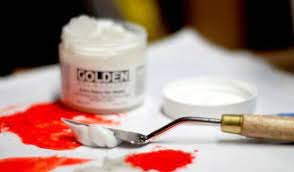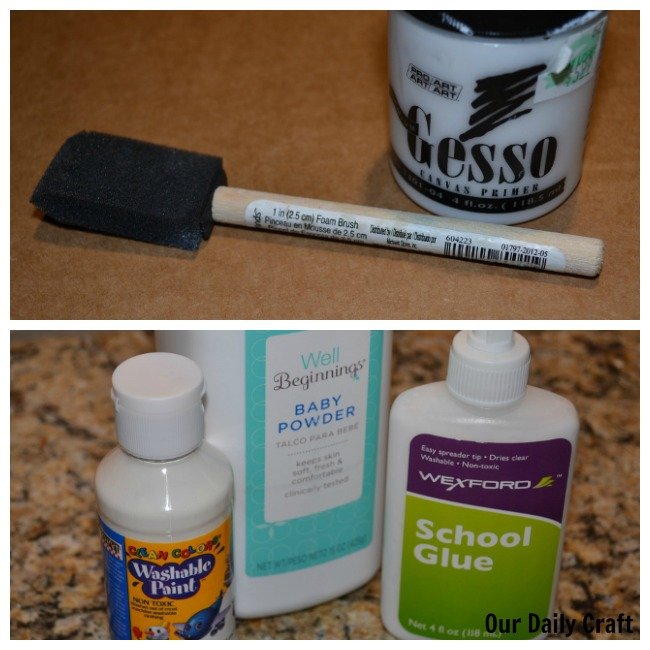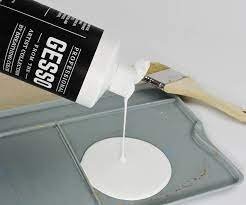Introduction
Acrylic Gesso is the first to be used on canvas or other supports of painting. This is how Gesso prepares the (“prime”) painting surface. It dries, making your support more rigid, slightly textured, and ready for acrylic painting. The paint would sink into the canvas without gesso. now you might have a question in your mind does gesso go bad?
Gesso does not go bad. But if you purchase it in bulk and open the seal of the bucket, use it in a small amount and keep it aside. It may be a waste. If you don’t use it frequently then you may find greenish crud around the top and a foul smell. That means the gesso you have has gone bad.
If you keep it open it might grow mold over the gesso. But if you put a plastic seal over it after use then it won’t go bad. If you don’t clean the jar rims after use with a wet cloth, then it will be stuck like gorilla glue. They have a very good insert in the lids and there’s no problem sticking if the joints are clean of gesso.

1 pint of gesso covers approximately 12.5 to 37.5 square feet. It is recommended to mix 2 tablespoons of primer with a tablespoon of thinner for every 18×24″ canvas meant for Oil Priming White (3 square feet).
Applying at least two coats of Gesso to any surface is recommended, but especially when painting on canvas or linen. The first coat will permeate the support, lowering the chances of paint delamination. The second coat adheres to the first and starts to smooth out the surface.
What is Gesso?
Gesso is an essential art supply that is widely used by painters to make their canvas ready for painting. Acrylic gesso serves to protect raw canvas from the deteriorating effects of oil paints while also providing a smooth and resilient surface for oils and acrylics to perform at their best. Although most acrylic gesso is similar to white acrylic paint in consistency and opacity, it comes in a wide range of thicknesses and opacities.
Although gesso is traditionally white, it is now also available in black, clear gesso, and colored gesso.
You can also dye your gesso to achieve any desired color. Simply add a few drops of acrylic paint to the gesso and you’ve got colored gesso.
The consistency and texture of gesso vary based on the brand. Some are thinner and more viscous liquid, while others are thicker. Some go on more smoothly, while others leave a textured finish. You’ll have to try a few different brands to figure out which one you prefer.

Why does Gesso go Bad?
If you don’t store gesso in a proper manner then it can cause growing bacteria or mold. When you don’t close the lid properly and oxygen gets in, it will dry out. If you mix up a cup of gesso to use and dump the leftover into the jar and use the tap water to clean the brush, it can mess up the gesso. Just close the lid or keep the gesso in an air-tight container after use. When you won’t use the gesso for years it may develop a foul smell and you can see mold growth then it might have gone bad.
Can Gesso Grow Mold?
Gesso can encourage the growth of mold and bacteria. Contamination is the main reason you’ll notice mold growing in gesso. Water exposure or wet brushes dipped into the container are the most common causes. Even the tiniest bacteria that may have been present in the water is quickly absorbed by the gesso.
Bacteria can quickly become an issue, which is exacerbated when the container is kept in a warm environment. Bacteria thrive in moist, warm environments, so it’s critical to avoid cross-contamination.
To avoid contamination avoid putting leftover gesso into the main container. Always dispose of it after use. Don’t put any paintbrushes or other art tools into the container.

How Long Does Gesso Paint Last?
Gesso does not go bad until you store it poorly. The life of gesso depends on how you use it. A container of gesso can last for a few years if you take care of it properly.
When you’ve had a gesso container for a long time, you’ll notice that the acrylic medium and gesso paint have separated. Because the gesso is much heavier than the medium, they will easily separate if left unsupervised for a long time.
If your gesso has separated, it doesn’t necessarily mean it’s bad and should be discarded. It’s as simple as mixing it back together and it’ll be ready to use again. You must take precautions to ensure that your gesso lasts for an extended period.
How to know if the gesso has gone bad?
Your gesso does not smell badly normally. The paint was probably adulterated if you decided to open your container and saw a terrible smell. The smell may come from molds or other bacteria that have entered the gesso. Some people have reported it smells like a rotten egg. So if you find any foul smell from the container of gesso, it might be contaminated. You may see greenish crud on the top layer as well.
What Precautions to be taken to save the gesso

To save your gesso from getting contaminated you need to follow certain things:
- Always keep your gesso container in cool, dry place to prevent drying up.
- You can use a plastic wrap between the lids and container so that no oxygen gets into it and contaminate it.
- Wipe the jar rim after using with a piece of wipe cloths before you close the lid. But remember there should not be any water dropped into the jar or else it will be contaminated.
- Never put any paint brush or any other art supplies directly into the container, even if they are clean. If possible, take a separate cup where you can mix the gesso and the paint properly. Never put the leftovers into the main container again. It will certainly contaminate the whole gesso in the jar.
- If you keep it untouched for years and see the ingredients fall apart, don’t forget to stir it properly and then use. Until it leaves a foul smell or a visible crud or mould growth, you can use it.
- Try to use acrylic medium or distilled water to thin gesso. Never use tap water. It will contaminate gesso.
FAQ
Does Gesso Expire?
There is no precise expiry date for Gesso. Unless properly handled, the gesso is probably never going bad. To make sure you are using your gesso for as long as possible, the main thing is to close your container as firmly as possible.
Why Does Gesso Smell Bad?
Generally, gesso smells like ammonia and it is normal. When you see any greenish crud on the top layer of the gesso container, it might have developed bacteria in it. It can leave a rancid smell like rotten eggs.
What can I substitute for gesso?
Commercial acrylic medium, rabbit skin glue or clear gesso can be the best substitutes for gesso. If you work with acrylics, you can paint directly on a surface without any pre-production, or you can make gesso easily at home with ingredients that can be bought almost anywhere if a cheap alternative to gesso is needed.
Final thoughts
When you are a professional and want to purchase art supplies in bulk, you should be conscious of whether the products will go bad over time. If you are buying gesso in bulk quantity and store it properly, it won’t go bad. But remember to close the lid tightly after use and to avoid greenish mold growth, never dip your paintbrush into it. Always use fresh water to clean the brush and properly dry it.















































